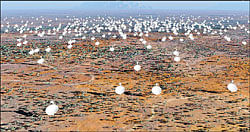India set to become part of biggest radio telescope project

As many as 67 organisations from 20 countries are involved in building the 1.5 billion Euro telescope known as Square Kilometre Array (SKA). It will be a gigantic radio telescope comprising 3,000 dish antennas, each about 15 mt wide, spread over a distance of 3,000 km.
Founding board members
Last month, nine nations, including Australia, China, France, Germany, Italy, the Netherlands, New Zealand, South Africa, and the UK, established the SKA founding Board at a conference in Rome.
India, however, could not sign in the letter of intent in Rome due to an administrative problem.
Nobody from the two possible funding agencies — the department of atomic energy or the department of science and technology were present at Rome where India was represented by a scientist from the National Centre for Radio Astronomy, Pune. But, there was a “good chance” that India would formally become a member of the SKA Board when the member countries would meet again in Canada in July, NCRA director S K Ghosh told Deccan Herald.
To become a member of the founding board that will steer the SKA project for the next two years till the construction begins, India has to shell out 50,000 Euro (about Rs 40 lakh), which could be taken from the annual budget of any of the scientific departments.
However, the financial contribution would go up when the construction starts.
A Cabinet approval would be needed at that time because the contribution would typically be in the range of a few hundred crore —10 per cent of the total project cost.
Raman Research Institute in Bangalore is a partner in initial studies to finalise the SKA site. The telescope will be located in either Australia–New Zealand or in Southern Africa. A final decision will come in this regard in 2012.
Once operational, the SKA will address a wide range of fundamental questions in physics, astrophysics, cosmology and astrobiology. It can investigate previously unexplored parts of the distant Universe and find out the origin of magnetism.
The project will also drive technology development in antennas, fibre networks, signal processing, software and computing. Spin off innovations in these areas will benefit other systems that process large volumes of data.
Tata Research, Development and Design Centre is already a part of it through its linkage with NCRA and India may rope in more industries at the time of construction.
